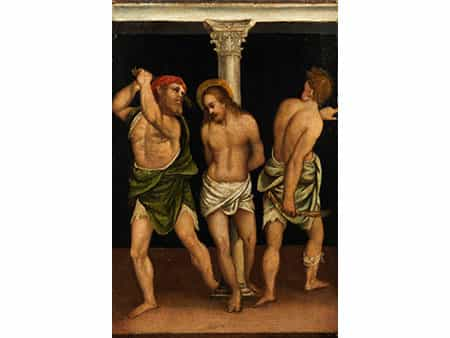Votre recherche Amico Aspertini dans la vente
Tableaux du XVI - XVIII siècle
jeudi, 22 septembre 2016
» reset
Votre assistant d‘art personnel

Vous êtes intéressé par des œuvres de Amico Aspertini?
Nous vous informons volontiers si les œuvres d‘art de Amico Aspertini vendus dans une de nos prochaines vente aux enchères.
Veuillez accepter notre politique des confidentialité
882
Amico Aspertini,
ca. 1474 Bologna – 1552
GEISSELUNG CHRISTI Öl auf Holz.
46,5 x 30,5 cm.
Prix de catalogue € 30.000 - 50.000
Prix de catalogue€ 30.000 - 50.000
$ 32,400 - 54,000
£ 27,000 - 45,000
元 234,600 - 391,000
₽ 2,984,700 - 4,974,500
Die Infrarot-Reflektographie zeigt die darunterliegende Vorstudie, die von sicherer Hand gezeichnet und kohärent mit der zeichnerischen Technik von Amico Aspertini ist.
Dieses Gemälde, das bis vor kurzem fast in Vergessenheit geraten war, hat ermöglicht, den Werkekatalog von Amico Aspertini hinsichtlich seiner kleinformatigen religiösen Darstellungen zu erweitern. Anscheinend gibt es nur eine weitere von ihm gemalte Darstellung des gegeißelten Heilands, nämlich das Fresko im Bogen des Eingangs zur Sant’Agostino Kapelle in der Kirche San Ferdinando in Lucca. In beiden Fällen wählte Aspertini ein klassisches Darstellungsschema, also symmetrisch und zentrumsbezogen, mit einer Marmorsäule, an die Christus gefesselt ist, welche das Bild genau in zwei analoge Teileabschnitte untergliedert. Die szenische Darstellung beschränkt sich auf das Wesentliche, hingegen konzentriert sich der Maler vollends auf den Ausdruck und vermeidet Überflüssiges und Dekoratives, mit Ausnahme des korinthischen Kapitells. Die minimale Gestik der beiden Folterknechte, die ergebene Nüchternheit des Gesichtsausdrucks des Heilands und das Fehlen der Geißelungsspuren auf seinem Körper machen aus diesem Bild ein höchst privates Objekt zur Meditation über die Bedeutung der Passionsgeschichte. Wie stets hat Aspertini auch hier – er besaß tiefes archäologisches Wissen – die Figuren nach klassischen Skulpturen modelliert. Wie Giovanna Degli Esposti in der Beschreibung des Gemäldes anlässlich der großen monographischen Ausstellung in Bologna 2008-2009 sagte kann dieses Gemälde gut mit anderen Werken von Aspertini verglichen werden, zum Beispiel den „Drei männliche Akte“, Kunsthalle Hamburg, die ebenfalls Ende der ersten Dekade des 16. Jahrhunderts entstanden sein dürften.
Literatur:
D. Scaglietti Kelescian, Nuovi dipinti di Amico Aspertini, in „Scritti di storia dell’arte in onore di Jürgen Winkelmann“, Neapel 1999, S. 325-333.
M. Faietti, Amico’s friend: Aspertini and the Confraternita del Buon Gesù in Bologna, in „Drawing Relationship in Northen Italian Renaissance Art. Patronage and Theories of Invention“, a cura di G. Periti, London 2004, S. 54.
G. Degli Esposti, scheda in Amico Aspertini 1474-1552. Artista bizzarro nell’età di Dürer e Raffaello, Ausstellungskatalog (Bologna, 27. September 2008 - 11. Januar 2009) a cura di A. Emiliani, D. Scaglietti Kelescian, Mailand 2008, S. 194, Nr. 53.
Ausstellung:
Amico Aspertini 1474-1552. Artista bizzarro nell’età di Dürer e Raffaello, a cura di A. Emiliani, D. Scaglietti Kelescian, Bologna, 27. September 2008 - 11. Januar 2009, Nr. 53. (1070902) (21)
Amico Aspertini,
ca. 1474 Bologna – 1552
THE FLAGELLATION OF CHRIST
Oil on panel.
46.5 x 30.5 cm.
An underlying preliminary sketch is revealed with infrared-reflectology. The sketch is executed with confidence and is consistent with Amico Aspertini’s drawing technique.
The painting, which up until recently had almost been forgotten, has made it possible to extend Aspertini’s œuvre with regards to small-format religious paintings. Only one other depiction of the Flagellation of Christ by the artist is believed to exist, namely a fresco in the arch of the entrance to the Sant’Agostino Chapel in the San Ferdinando Church, Lucca. In both cases Aspertini chose a classic composition. As Giovanna Degli Esposti pointed out in her description of the painting when it was shown at the great monographic exhibition in Bologna in 2008-2009, it compares easily with other works by Aspertini such as Three male nudes (Kunsthalle, Hamburg) which was probably also created towards the end of the first decade of the 16th century.
Literature:
D. Scaglietti Kelescian, “Nuovi dipinti di Amico Aspertini”, in Scritti di storia dell'arte in onore di Jürgen Winkelmann, Naples 1999, pp. 325-333.
M. Faietti, “Amico’s friend: Aspertini and the Confraternita del Buon Gesù in Bologna“, in G. Periti (ed.), Drawing Relationship in Northern Italian Renaissance Art. Patronage and Theories of Invention, London 2004, p. 54.
A. Emiliani and D. Scaglietti Kelescian (eds.) Amico Aspertini 1474-1552. Artista bizzarro nell’età di Dürer e Raffaello, exhibition catalogue (Bologna, 27 September 2008 - 11 January 2009), Milan 2008, p. 194, no. 53.
Exhibitions:
Pinacoteca Nazionale, Bologna, Amico Aspertini 1474-1552. Artista bizzarro nell'età di Dürer e Raffaello, 27 September 2008 - 11 January 2009, no. 53.
This object has been individually compared to the information in the Art Loss Register data bank and is not registered there as stolen or missing.
Votre assistant d‘art personnel
Vous voulez être informé quand dans nos prochaines ventes aux enchères une œuvre d‘art de Amico Aspertini sera proposée? Veuillez activer votre assistant d‘art personnel.
Veuillez accepter notre politique des confidentialité
Voulez-vous acheter une œuvre d‘art de Amico Aspertini?
Voulez-vous acheter un objet similaire? Acheter en vente privée dates de vente aux enchères
Nos experts vous aident personnellement dans votre recherche d‘objets d‘art.
Voulez-vous vendre une œuvre d‘art de Amico Aspertini?
Livrez maintenant Vente privée FAQ
Vos envois sont toujours les bienvenus. Nos experts se feront un plaisir de vous conseiller personnellement, nous nous réjouissons de votre appel.
Contactez nos experts
further catalogues Meubles et aménagements | Sculptures et arts décoratifs | Argenterie et porcelaine | Deux collections d'objets en ivoire | Boîtes et miniatures | Art russe | Tableaux du XIX siècle | Art moderne | Art d'Asie | Montres et horloges | Maroquinerie et bagagerie | Tableaux du XVI - XVIII siècle | Bijoux | Hampel Living














